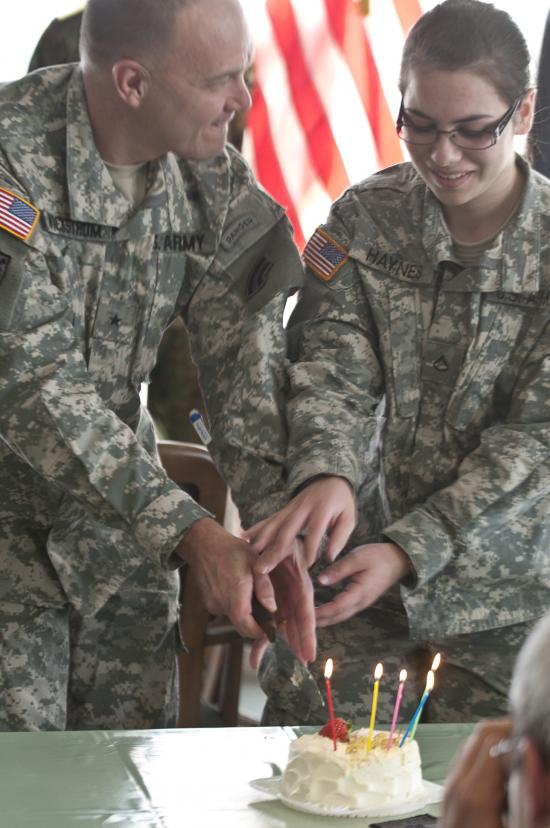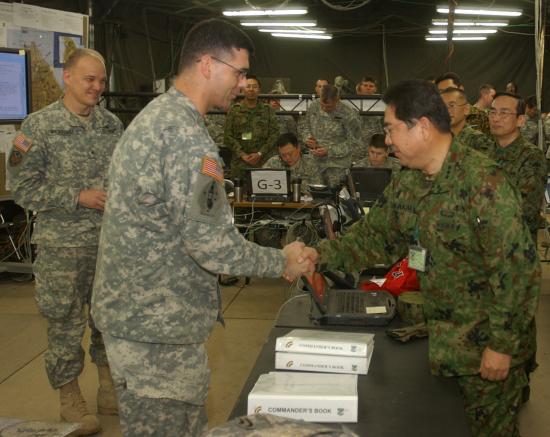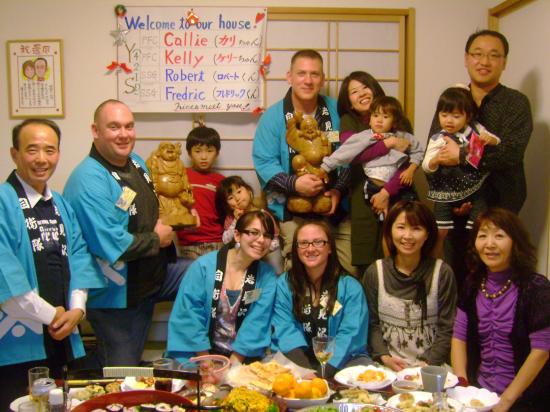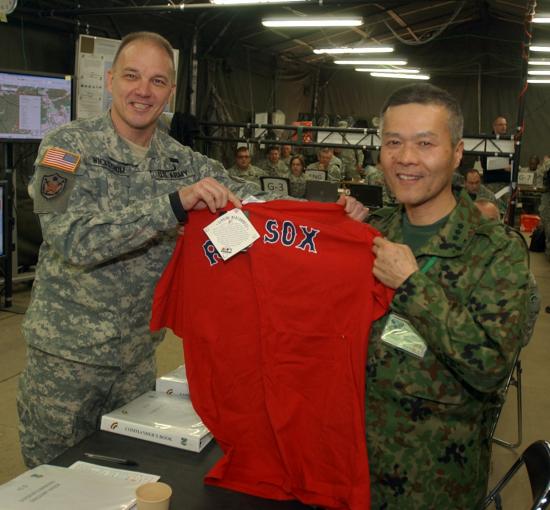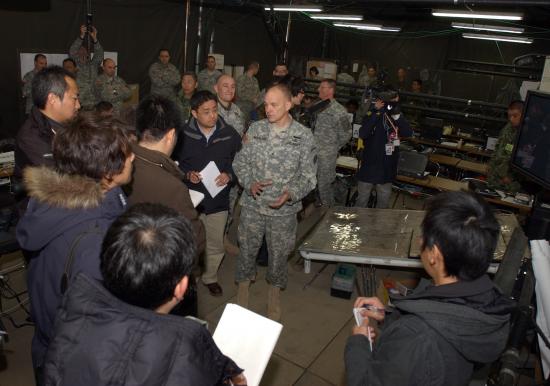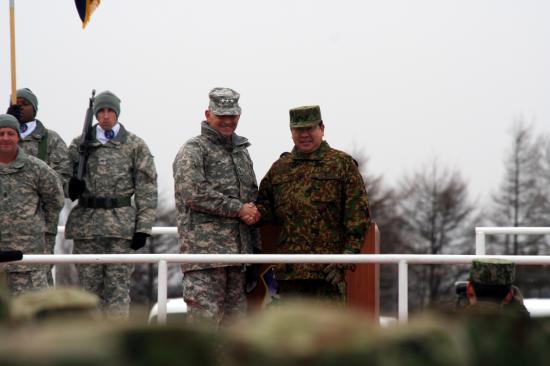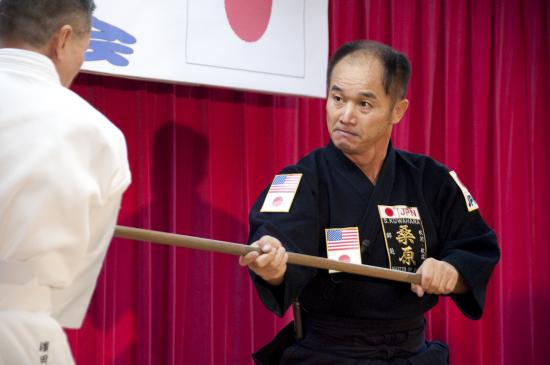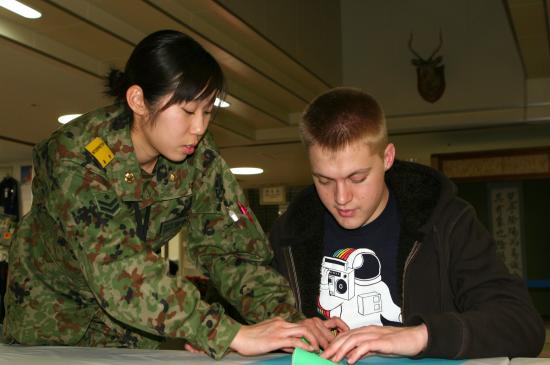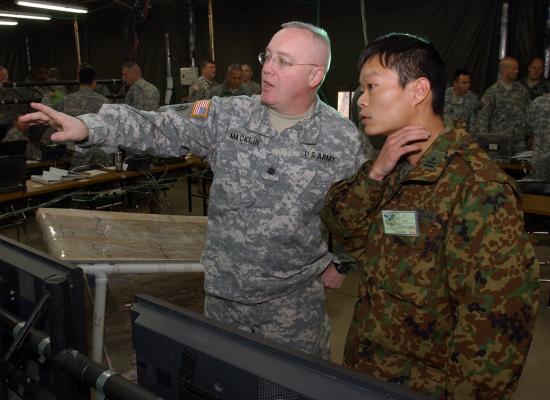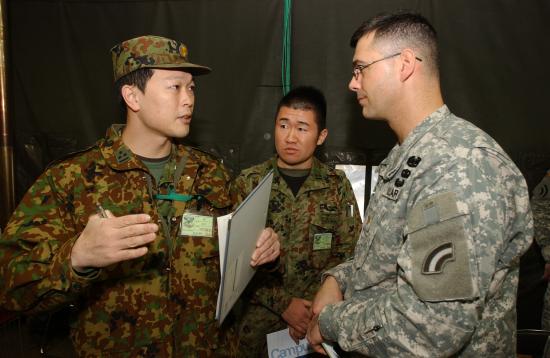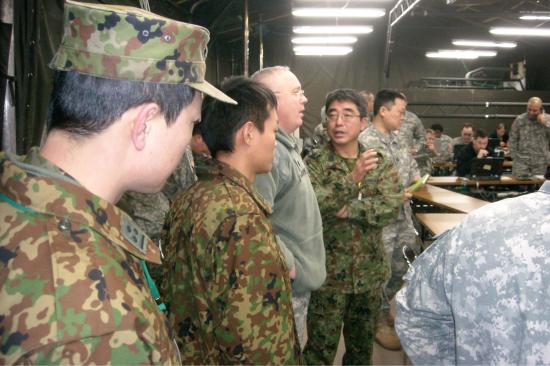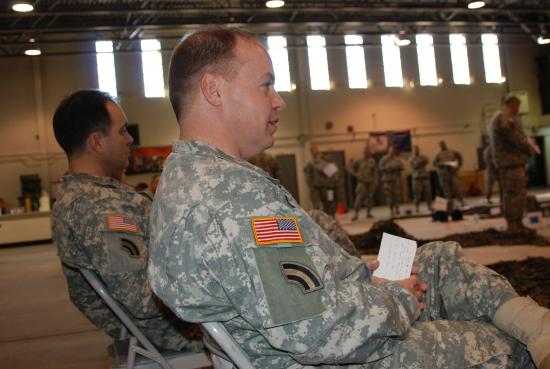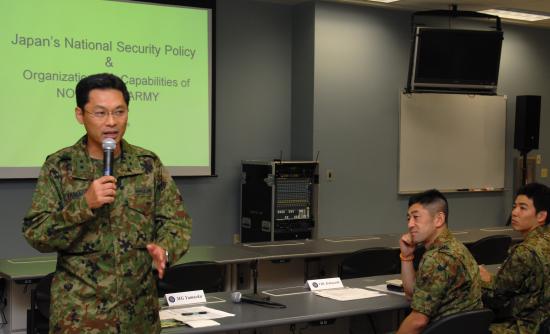Yama Sakura 57 Journal
Jump to:
Resources:
Browse All Journals-- Brig. Gen. Steven Wickstrom,
Yama Sakura Soldiers Celebrate National Guard Birthday
Guard Troops Likely the First Celebration Across the Force
CAMP CHITOSE, HOKKAIDO, JAPAN -- Representing the most senior Soldier and most junior Soldier of the assembled troops here for Yama Sakura, New York Army National Guard Brig. Gen. Steven Wickstrom (left) and division Soldier Pfc. Callie Haynes cut a cake to celebrate the 373rd Birthday of the National Guard during Yama Sakura 57 bilateral command post training exercise with members of the Japan Ground Self Defense Forces. The 42nd Infantry Division command and staff have been taking part in the exercise along with other U.S. military units and the Japanese Northern Army.
Yama Sakura Exercise Co-Director Congratulates Rainbow Staff, Soldiers
Division Hosts Visit of Northern Army Commander
New York Troops At Home in Japan
Deployed Rainbow Soldiers Enjoy Visits with Host Nation Families
By Staff Sgt. Raymond Drumsta, 138th Public Affairs Detachment
CAMP CHITOSE, HOKKAIDO, JAPAN -- There was some nervousness at first, but in the end, the similarities between the 42nd Infantry Division Soldiers and their Japanese hosts outstripped the differences.
“I felt completely at home and completely welcome,” said Sgt. First Class Denis Topliffe, who was one of eight division Soldiers selected to visit Japanese homes during Yama Sakura 57, the bilateral command post training exercise with members of the Japan Ground Self Defense Forces.
The visits were part of the exercise’s cultural exchange aspect. Most of the New York Army National Guard division’s command staff arrived here on Dec. 2, and accompanied by interpreters, the Soldiers visited the homes the following evening.
Topliffe, of Guilderland, and Warrant Officer 1 Kelly Fancher, of Valatie, visited the Segawa family. A family of five, the Segawas have three girls, ranging in age from 20 months to seven years old, Fancher said.
“I was excited to do it because it’s a once-in-a-lifetime experience,” Fancher said of the visit. “But I was nervous too.”
Fancher and Topliffe both like Sushi, and expected a traditional Japanese dining experience. In addition to Sushi, the Segawas served hotdogs, French fries and chicken -- all prepared equally well, Fancher said.
“It was good,” Fancher said.
They went out of their way to make food they thought was culturally appropriate, said Topliffe, referring to the American cuisine.
“Of course, I didn’t eat any of that,” Topliffe said with a smile. “I filled up on Sushi. It was fabulous.”
Though shy at first, the children grew more carefree as the evening wore on -- playing and horsing around, reminding him of his own children, Topliffe said. The fact that he is part-time soldier and fulltime special education teacher at Peter B. Coeymans Elementary School in Ravena helped as well, he added.
“When I told them my fulltime is teaching, they seemed more relaxed,” he said.
At the children’s request, he and Fancher sang “Twinkle, Twinkle, Little Star,” Topliffe said. They then sat on the couch and enjoyed the children’s rendition of the song -- in Japanese, he explained.
Staff Sgt. Fredric Trunzo, of Buffalo, visited the Ikeda family with Staff Sgt. Robert Lant, of Staten Island, and Pfc. Kelly Rushing and Pfc. Callie Haynes, both of Saratoga Springs. Trunzo said he felt privledged to visit with the Ikedas -- and nervous.
“I wanted to make sure I represented my unit and the United States as best as possible,” he said.
But when he saw the trappings of the Ikeda home -- which included a living room with a television set and the childrens’ toys -- Trunzo, too, felt right at home.
“It looked like my home,” he said. “There doesn’t seem to be any differences in how we live our daily lives.”
One new experience was sitting cross-legged at the Ideka’s foot-high table, dining on Sushi and a enjoying a number of dishes, most of which he didn’t know the name of, he said.
“It was huge spread,” he recalled. “There was probably 20 different Japanese food items. It just kept coming.”
They ate while wearing ceremonial robes the Idekas had provided, and “talked about everything” -- from music and Michael Jackson to Pokemon, Trunzo said. They also spoke with the Ideka’s grandfather, a former major and engineer in the Japanese Defense Forces, he added.
The Soldiers said they exchanged gifts like Japanese fans, baseballs, T-shirts and the 42nd Division rainbow patch.
It seemed as though the Segawa’s children didn’t want the evening to end.
“They actually didn’t want us to leave,” Fancher said. “One of them was crying.”
It was wonderful that they created a bond in such a short time, Topliffe said. For him, the evening with the Segawas hearkened back to his experiences in a Egyptian cultural exchange program and his interactions with Iraqi civilians while helping them to rebuild a school in Tikrit.
“It doesn’t matter where I go in the world, people are all the same,” he said.
42nd Division Shares Lessons, Baseball Lore with Japanese Counterparts
Yama Sakura 57 Brings Division Leaders Together
CAMP CHITOSE, Hokkaido, Japan -- New York Army National Guard 42nd Division Commander Brig. Gen. Steven N. Wickstrom (left), and Lt. Gen. Hiroshi Yamamoto, commander of the 7th Division, Japan Ground Defense Forces, pose with a Red Sox t-shirt Wickstrom has just given Yamamoto Dec. 10. Wickstrom, a Massachutsetts resident and Red Sox fan, presented the gift during Yamamoto’s visit to the 42nd Division Command Post. Wickstrom told Yamamoto that as commander of a New York National Guard unit, he was sure that the gift would shock his own staff, but it was representative of his hometown.
The Red Sox baseball club is famous throughout Japan because of the performance of Daisuke Matsuzaka, a native Japanese pitcher who plays in Boston. Matsuzaka’s name and number appear on the back of the t-shirt presented to Yamamoto.
The two military units are taking part in Yama Sakura 57, the bilateral command post training exercise with members of the Japan Ground Self Defense Forces. The 42nd Division provided Yamamoto and his division staff with an overview of U.S. Army command and control technologies and techniques along with an overview of the division’s history with the Army National Guard.
Photo by Staff Sgt. Raymond Drumsta, 138th Public Affairs Detachment.
Video Story Now Available
View 42d Infantry Division Video Footage at the Military's Digital Video and Imagery Distribution System for Yama Sakura 57
http://www.dvidshub.net/?script=video/video_show.php&id=74724
http://www.dvidshub.net/?script=video/video_show.php&id=74725
Meet the Press, Yama Sakura Style
42d Infantry Division Commander Welcomes Japanese News Media
Yama Sakura 57 Opening Ceremony Imagery
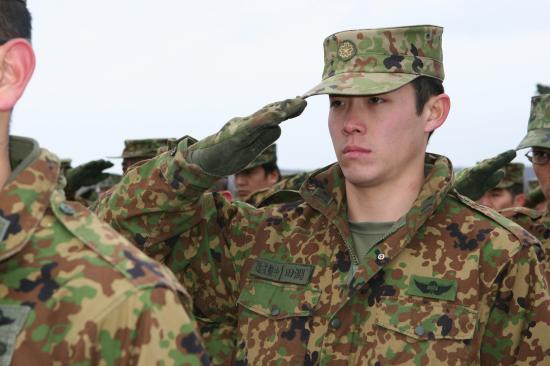 |
Photo courtesy 124th MPAD. |
Rainbow Reaches the Rising Sun
Opening Ceremony Marks the Start of Yama Sakura 57 in Japan
Ancient Skills on Display
Yama Sakura Social Interactions Provide Troops with Slice of Japanese Culture
Getting Cultured
Link to Yama Sakura 57 Website
If you want to learn more about exercise Yama Sakura 57, here's a link to the office US Army Japan Website on the event.
Back To Basics
War Game in Japan Tests Rainbow Soldiers’ Skills
By Staff Sgt. Raymond Drumsta, 138th Public Affairs Detachment
CAMP CHITOSE, Hokkaido, Japan -- The theater of operations and terrain is new, but the New York Army National Guard’s 42nd Infantry Division warfighters are treading familiar territory in Yama Sakura 57, a bilateral command post training exercise with members of the Japan Ground Self Defense Forces.
The exercise finds the division staff sections in Japan, taking on a war game scenario involving conventional forces. Though engaged in counter-insurgency operations in Iraq and Afghanistan, the Army has identified a need to train in full spectrum conventional warfare operations, according to Lt. Col. Robert Bready, who’s in charge of the division’s effects coordination cell.
“This training exercise gets us back to using our traditional skills,” said Bready, who’s from Highland, N.Y. “We have to get back to basics, and this is how we do it.”
The exercise, scheduled for Dec. 8-13, involves a notional battle to defend Japanese sovereignty. About 100 Rainbow Division Soldiers are at Camp Chitose, located on the northern Japanese Island of Hokkaido, where they’re in command and control of simulated 42nd Infantry Division units. In the exercise, the division is part of Joint Task Force One Team, a notional task force composed of American and Japan Self-Defense Forces on Hokkaido, Bready said.
In a conventional counter-attack operation involving delaying tactics, obstacles, artillery and maneuver on narrow valley and coastal roads, the task force intends to draw the enemy in, outflank and destroy them, he explained.
“It’s a full-spectrum operation,” Bready said. “It’s a conventional combined arms fight.”
While the tactical scenario stands in stark contrast to the division’s 2005 Iraqi counter-insurgency operations, the command and control aspect isn’t “significantly different,” Bready said.
“We have a lot of moving pieces,” he said. “But we’re still controlling forces on the ground and supporting the troops like we did in Iraq. We’re all training in our base skills, which can translate into all these areas.”
Two of those pieces are artillery and helicopters. One of the staff’s challenges is to ensure that none of Team One’s helicopters flies through the trajectory of its artillery, said Lt. Col. John Betor, a division aviation officer from Saratoga Springs, N.Y.
Betor said the staff will restrict helicopters to specific geographic zones and ensure that flight data is entered into artillery computer systems, he explained.
“If everyone’s on the net and working, we’ll avoid friendly fire incidents,” Betor said. He referred to this process as “de-conflicting.” In the context of the war game, the staff will have to deal with notional factors such as weather and the enemy’s air-defense artillery.
“It resembles a cold-war army,” Betor said of the enemy forces in the war game. “They have a lot air-defense artillery.”
Though these battlefield factors are only notional, the staff usually gets into the game, which increases the pressure - which is the whole idea, Bready said.
“At times the intent is to build stress, and force people to think and make decisions,” he said. “It’s training in critical thinking and response.”
These skills can be applied to stability, peacekeeping and humanitarian operations, Bready said.
“We’ll be able to respond to a variety of situations,” he said.
The exercise continues with week with division command staff coordinating their actions with command staffs of the 2nd and 7th Divisions of the Japan Ground Self-Defense Forces.
In addition to its bilateral aspect, the exercise is important because United States active duty and reserve components are working together, Bready said.
“You have a National Guard division headquarters working for an active duty corps headquarters,” he said. “Because of the operational tempo and the current world situation, the National Guard has become a key operational component of national defense.”
Rainbow Soldiers Arrive in Japan
Troops Prepare for Yama Sakura 57 Exercise
CAMP CHITOSE, Japan -- Approximately 120 New York Army National Guard Soldiers arrived here over the past four days for Yama Sakura 57, the bilateral command post training exercise with members of the Japan Ground Self Defense Forces.
The Soldiers will now establish the division headquarters command post and communications infrastructure to support the full spectrum battle simulation exercise next week.
The troops acclimated quickly to Northern Japan’s cold climate. With temperatures and a wind chill reaching down to the lower teens, most of the New York Army National Guard Soldiers left autumn at home much warmer than the environment on Hokkaido.
Ten of the division’s Soldiers already received a warm welcome as part of the cultural exchange program for Yama Sakura. The New York Soldiers were received at the homes of Japanese army troops volunteering to open their homes, their families and their culture to the New York Army National Guardsmen.
Yama Sakura 57 involves a military to military exchange to better prepare both forces for full spectrum conflict and train Japanese Ground Self Defense Forces for their homeland defense mission.
The command post exercise, scheduled for Dec. 8-13, involves a notional battle to defend Japanese sovereignty. It is one of the U.S. Army’s largest such training events for high intensity, or full spectrum, conflict.
“About sixty percent of our effort here is just the military to military relationships and cultural exchange with our Japanese partners,” Command Sgt. Major John Willsey said. Willsey, from the 42d Special Troops Battalion, supervises the Soldier care and life support issues for the deployed troops.
“The other forty percent of our effort is the exercise itself,” Willsey noted. “Training with the Japanese Ground Self Defense Forces is an exchange of techniques and lessons learned that make both our forces better at what we do.”
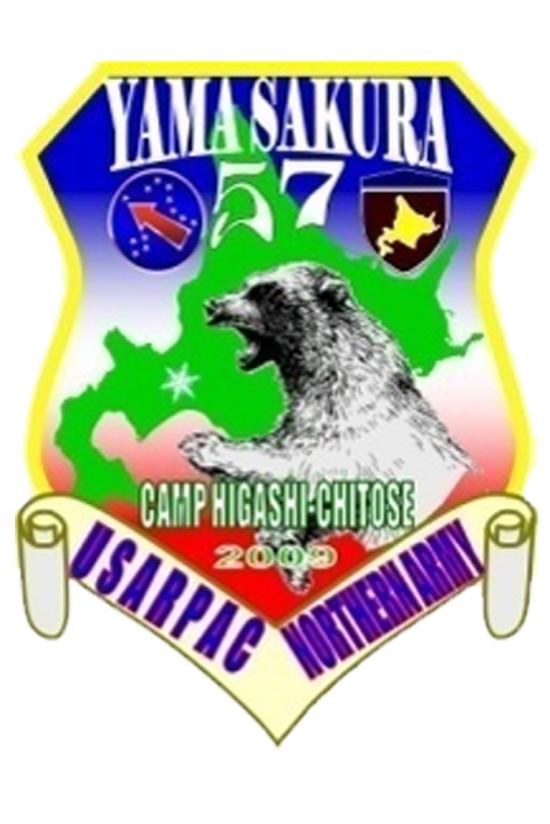 |
The Yama Sakura 57 Exercise Logo |
Yama Sakura 57 Set to Begin Next Week
Troops to Deploy to Northern Japan After Thanksgiving Holiday
TROY, N.Y. -- New York Army National Guard Soldiers from the 42nd Infantry Division Headquarters deploy next week to Hokkaido, Japan for a two-week training exercise alongside troops of the Japanese Ground Self Defense Forces (JGSDF).
Nearly 70 Citizen Soldiers from the division’s headquarters in Troy will fly to Northern Japan and Fort Lewis, Washington next week to support the training.
They will be joined by nearly 30 Soldiers from the division’s tactical command post based in Buffalo, N.Y. and approximately 50 more Soldiers from the division’s second tactical command post in New York City. A dozen more Soldiers will depart from the Central New York region near Syracuse for the deployment as well.
In all, about 100 Citizen Soldiers will deploy to Japan and 60 will support the battle simulation exercise from Fort Lewis, Washington.
The bilateral training exercise known as Yama Sakura, brings together U.S. and Japanese forces to better develop the U.S. and Japanese military to military relationship and provide a forum for training senior leaders and staffs for conflict.
The training involves a command post exercise, a battle simulation that will challenge the senior leaders of both U.S. and Japanese forces for high intensity conflict.
“This is our profession and our craft,” said Brig. Gen. Steven Wickstrom, the 42nd Infantry Division Commander to his assembled staff leaders during a combined arms rehearsal prior to deployment. “We need to do this training to improve our profession and continue to learn.”
The training for high intensity conflict is a return to a more conventional employment of an Army ground combat division headquarters. The 42nd Infantry Division deployed to Iraq in 2005 and conducted stability and support operations as part of the wider counterinsurgency fight during Operation Iraqi Freedom.
Gen. George Casey, the Army Chief of Staff, has emphasized the training for conventional warfare since 2008.
“When I was a divisional commander in Germany in ‘99 to 2001, if you had asked me where I should optimize my training on the spectrum of conflict so I could be the most versatile, I would have said, If I can do conventional war, I can do anything,” Casey said in remarks to the Army News Service in August 2008.
“After 32 months in Iraq, I don’t believe that... (and) mostly the Soldiers that have been to Iraq and Afghanistan don’t believe that, either,” Casey said. “There’s enough difference, some fundamental differences between irregular warfare and major conventional warfare that we need to...be more versatile,” Gen. Casey said.




